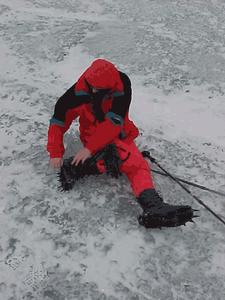13 April, 2003
Sunday morning is everyone's off day. The station operates 7 days a
week so there is no such thing as a whole off day just a half off
day. My Sunday began with a whole new experience. I went hiking up
my first glacier this morning. It was so much fun. I loved it
because there were no boulders or rocks to slip and fall on. We used
crampons to hike the slick glacier face. A glacier really is a river
of ice. It is so slow moving that you can't feel it, but it is
moving. We heard it calve 4 times while we were hiking. Black flags
and guide lines keep you from going into a dangerous part of the
glacier that has crevasses or is calving.
My workday began Sunday afternoon at 1 PM with a team meeting. I was
assigned to tender a dive team.
Sunday night I helped in the aquarium room. I fed the sea stars.
The experimental pellet had tunicate extract in it. We did not want
the sea stars to like it, but they did. All we can do is record the
data.

I'm hiking the glacier. We use ski poles to steady ourselves with. Ski poles are also used to poke at the snow. Crevasses can be hidden by snow, so by poking at the snow I can tell whether or not it is o.k. to step into it.

I made it to the top of the glacier! It is dangerous to go down the other side because there are large crevasses there. The sign indicates the danger. There are lines, flags, and poles strung to guide us. I had to stay within the guides. The guides are checked periodically so that if conditions change, the guides can be changed to keep people who are hiking the glacier safe.

While hiking I took some pictures of the area. I liked this one because it shows three different layers of atmospheric conditions. The bottom layer is a rocky island close by. Behind that and miles away you can see a cloud layer settling in a valley. Then, farthest in the scene is the sun shining on a snowy, white, high mountain.

Lichen are one of the flora that grow along the Antarctic Peninsula. There are also mosses here.

The scientists call this the tourist tank. It has a variety of Antarctic marine life in it. This is the tank they show the tourists when criuse ships dock at Palmer.

This is the aquarium that holds the collected seastar samples for experiements. They will be released back into the sea when the scientists return to the states.

Seastars climb to the top of the tank and stretch their arms out. Twelve seastars with stretched out arms are given 2 food pellets one at a time. The first pellet is the experiemental pellet with an extract in it to see if they will eat it or not. The second pellet is a krill pellet, the control pellet, because we know they will eat krill. If the seastars eat the experimental pellet, then they will probably eat the control pellet since they like krill or they were just very hungry. If they eat the experiemental pellet and not the krill pellet, we have to test another seastar, the experiemental pellet becomes null. If the seastars don't eat the experiemental pellet or the control pellet, they are probably just not hungry, it becomes null, so we have to test another seastar.

I'm feeding the seastars.

Before we ever leave the station to go anywhere, we must sign out so that everyone will know who has gone and where they have gone. This is a safety measure in case there is an emergency or injury, search and rescue will know where to look for you.

These are crampons. They are used to help climbers and hikers get up the ice. Ice is slippery. Crampons have sharp spikes on the end. Instead of stepping, you pick up your foot and stomp it into the ice which holds you, that way you don't slip and fall.
Contact the TEA in the field at
.
If you cannot connect through your browser, copy the
TEA's e-mail address in the "To:" line of
your favorite e-mail package.
|
